Reference no: EM132062552
Project Management
Objective:
Demonstrate the ability to apply knowledge of one aspect of project management (risk management) in a case study.
Tasks to be undertaken:
You have been approached to:
1. Research and select an appropriate technology to produce sanitary hot water for a small hotel (three floors, 20 guest rooms, one small kitchen) in Nairobi in Kenya using solar energy.
2. Conduct a risk management plan for the installation and operation of the selected system.
The contractor has asked you to provide a technical report including the following:
- Technical description of the solar energy system.
Please include information about:
o Justification of the selection of the particular system
o Stages or components (including ancillary equipment, if appropriate)
o Potential dimensions of the system (e.g. capacity, volume of heated water, etc.)
o Basic explanation on how the systems work (e.g. solar input, temperature of the sanitary hot water, etc.)
Maximum length of the section: 1 page
- Describe any industry standards or legislation relevant in Kenya related to the installation and operation of this type of solar energy system (or regarding their inputs and/or outputs, if appropriate)
Maximum length of the section: half page
- Conduct a risk assessment for the installation and operation phases of the selected solar hot water technology. Include:
o Hazard identification (as comprehensive as possible, i.e. physical, mechanical, electrical, work practices, environmental, hazardous substances, handling, fire hazards, etc.)
o Risk rating (likelihood and severity) - justify your rating
Maximum length of the section: 2 pages
- Suggest risk mitigation measures for all hazards you identified in both phases
- Re-calculate the risk rating to demonstrate the minimisation of risks.
Maximum length: 2 pages
- Conclusions: summarise the main findings of your risk assessment and provide some design recommendations that could minimise the identified risks. For example, changes in the design of the selected technology, type of materials of its components, etc.
Maximum length: half page
Assignment 1
Design Analysis Assignment
PART-A
The aims of the assignment are to understand the principals of 2D - Design Analysis and to carry out Finite Element Analysis on Simple Plate of size to be individually determined Y- between 100mm and 200mm, Z = Y/2; X = Y/2; C=Z/2 and D = 20% to 40% of Z, See figure below. The plate has uniform thickness of Z/5. (PLEASE ENSURE INDIVIDUALITY). Further aim is understand any differences between 2D and 3D analysis and effects of design change and mesh density.
The objective is to produce a Simple Plate in the design package within the FEA package and applying the boundary conditions and loads at the surface edge of the plate. You are to perform static stress analysis with linear material models on a classical problem by utilizing different mesh densities. Attempt various mesh densities starting from 200, etc. Fix one end of the plate and apply surface force of 60KN on the opposite edge(convert to Pressure initially). Compare 2D analysis results with 3D analysis. Further analysis can be carried out on a different section, such as a plate with Semi-circle notch on opposite edges. See below Look for an actual product which has a component that is under tensile loading. Apply this type of analysis to a component and discuss the results.
This will develop your ability to understand the application of design packages, the effects of mesh density and to formulate decisions based on results obtained
Open AlgorAutodesk SimulationFEA package and build the model in 2D and carry out the analysis.
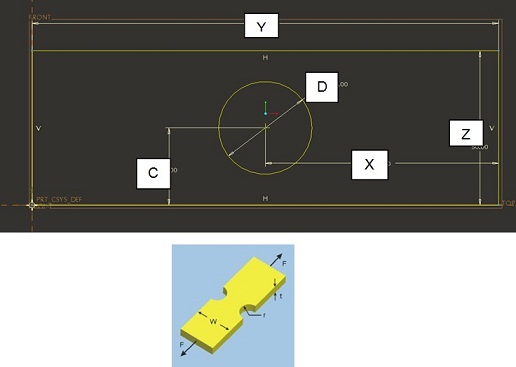
Calculator for Stress Concentration Factor.
Initial Conditions: Fixed Boundary Conditions to be applied to one edge of the plate and a force of 60KN to be applied on the opposite edge.
Material to be used is Steel 4130 as listed in the materials library.
Marks will be awarded for the following.
Describing and explain the steps taken to produce the design and to carryout analysis with relevant printouts.
Discussing the results obtained and exploring variations and making recommendations. Evaluating and reporting on the effect of mesh density and comparing it against the stress concentration factor obtained.
Comparing with 3D analysis of a STEP model from Creo - PTC
Evaluating the Effects of different diameters can also be considered together with different type of a hole for example square& notch.
Verifying the results using classical methods
Look for an actual product that has a component that is under tensile loading. Apply this type of analysis to a component and discuss the results.
Part B
The aim of the assignment is to develop your ability to model and analyse a component using design tools. The objective is to produce a design using a CAD package and to carry out Finite Element Analysis on an everyday engineering component. The product to consider is a common Bicycle Crank. Initial Dimensions for the Crank are as shown below.
Crank is modelled in PTC Creo other 3D design package and saved as a STEP file. CAD Data exchange file *.STEP is imported and analysed in Autodesk Mechanical Simulation FEA package. It is possible to read *.PRT files in FEA software
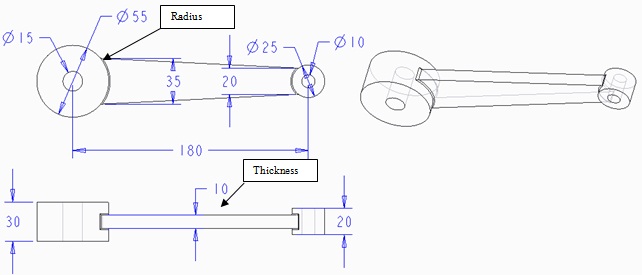
Dimensions for the Crank with Plain Hole
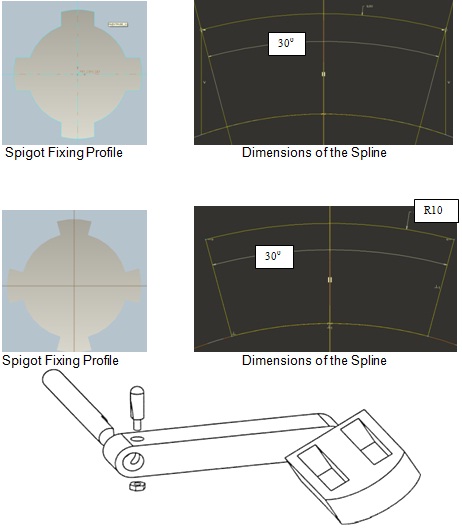
An Example Fixing the Crank
This will introduce you to creating a bicycle crank in a CAD package using PTC Creo3 transferring data into an FEA package such as Autodesk Simulation 2016. This will highlight the benefits that can be gained from using design tools in the design process.
Conditions: Fixed Boundary Conditions to be applied to the surface on the 15mm hole in the 55mmdia Boss initially.
Force of 1000N to be applied to the inner Nodes/Surface on the 10mm hole in the 25 mm boss on the Right Hand Side
Material to be used is Steel 4130 as listed in the materials library.
Design Safety Factor to consider is 3:1 at the Radii
Marks will be awarded for the following
Discuss the steps taken to produce the design and analysis with relevant printouts.
Consider the effects of Fixed Boundary Conditions and the Force applied at Nodal points or the Surface.
Discuss the results obtained and make recommendations.
Discuss the results obtained and explore variations and make recommendations. Evaluate and report on the effect of mesh density and the optimised shape of the Crank considering the effects of different radius and thickness as highlighted above on the Crank body.
Consider other analysis model such as an assembly with a Spigot in the Crank.
Verify the results using classical methods
Compare and Comment on the design of different type of fixing at the Crank and the spigot. For example a key or tapered spigot or as per example given in the handout
Part C
Bending Stress Analysis of structural Section - Such as a Universal Beam - I-Section. One Method of reducing weight of an I- Section and increase the load carrying capacity is to cut in Hexagon profile and weld the 2- sections as shown below.
Carryout Bending Stress on standard section and a modified section with Beam of 3-times the length given in the supplied model
For 1st analysis consider it as Cantilever with force 10KN; Consider the effects of temperatures in extreme conditions.
Attempt Modal Analysis.
Compare beam element type.
For 2nd Analysis consider it as a Simply Supported Beam.
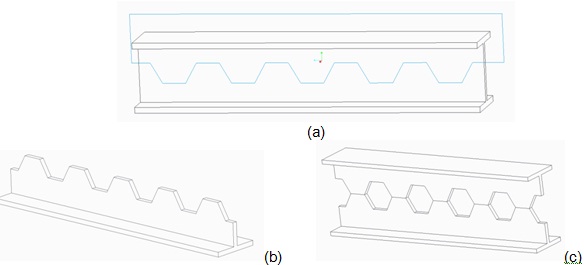
Part C - Bell Crank for Formula Student car in the workshop is given.
Look at the assembled components and discuss the loading conditions. Model the part with appropriate conditions and carry out analysis to determine the optimised the design with a safety factor of 3:1
Assemble pins in the holes and carry out further analysis for comparison. Look at the new design on the current car and compare.
Bell crank for Formula Student Car
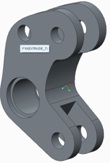
Part D
Discuss types of FEA methods and the benefits of applying design analysis in the Product Life Cycle, use examples to illustrate your discussion.
Assignment 2
The last few years have seen a number of devastating natural disasters, ranging from the Tsunami in the Indian Ocean to the Kashmiri earthquake. Each of these disasters requires a huge expenditure to ensure the minimum loss of life. The acute phase of recovery is the most widely publicised, but the ongoing, chronic, phase can last months or years where people need to live in poorer accommodation without the facilities that would normally be taken for granted. Your project is to research, design and (at least) model a product that can have a positive humanitarian impact in the aftermath of a natural disaster. This may range from a hand-powered mini-crane for rescue teams to a solar powered water purifier.
An alternative design project would be to look at a product to support the Physically Disadvantaged, such as motorised attachment for wheelchairs etc. or general product to improve everyday life.
You will be expected to draw on all aspects of this course and be able to demonstrate this in your assessment. You will be expected to research the product (need, potential market and competition) thoroughly and use sound design principles to reduce a number of possible solutions down to one that will be developed fully.
The group size should around 5-people. You should submit the names of people in your group by the end of week 18 together with the nature of the product you are working on and what you see as the initial project scope, no more than two sides.
Report should include minutes of project review meetings as the project progresses. The report should contain all of the above elements with clear drawings and text. You should try to use as many of design tools as possible for this project.
The investigation should include: -
Project Plan for the project for the group
Market research
Assessment of the market
Appraisal of the competition
Design specification
Criteria by which the product is to be judged and placed in ranking order.
Safety requirements etc (regulation or standards)
Consider IPR
Possible solution and evaluation
Final Design proposal
Product Design Specification.
Manufacturing Methods
FEA Analysis - Product Verification
Full design and detail of the product. (3D models and detail drawings) together with possible prototypes.
Your report will be submitted to the Faculty of Technology Advisory Centre office (FOTAC).
Attachment:- Assignment.rar